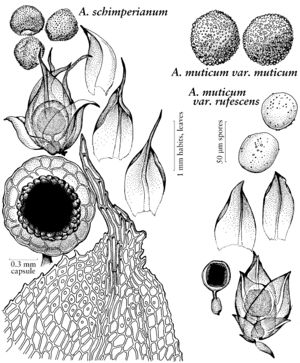Acaulon
Bot. Zeitung (Berlin) 5: 99. 1847 ,.
| Taxon | Illustrator ⠉ | |
|---|---|---|
 | Acaulon schimperianum | Patricia M. Eckel |
Plants bulbiform, gregarious or scattered, reddish to yellowish-brown distally, brown proximally. Stems short, to 0.5 mm; hyalodermis absent, sclerodermis absent, central strand absent; axillary hairs to ca. 5 cells in length, proximal cell-walls sometimes thickened. Stem-leaves strongly appressed and apices usually reflexed when dry, appressed to weakly spreading when moist; ovate, adaxial surface deeply concave, 0.5–1.75 mm; base not differentiated in shape, proximal margins not differentiated; distal margins plane or very weakly recurved, entire to serrulate or dentate; apex broadly acute, abruptly apiculate; costa excurrent in a stout, sharp apiculus, occasionally as a short, occasionally dentate awn, adaxial outgrowths absent in American species, adaxial cells elongate, in 3–4 rows; transverse-section round, adaxial epidermis present, adaxial stereid band absent, guide cells 0–4 in 1 layer, hydroid strand usually present, occasionally central, abaxial stereid band present, usually weak, rounded in sectional shape, abaxial epidermis present; proximal cells not differentiated in shape, rectangular, little wider than distal cells, 3–4: 1, walls of proximal cells thin; distal medial cells roundedquadrate to rhomboid, ca. 13–15 µm wide, 1–4: 1, 1-stratose; papillae absent or occasionally large and simple, one per lumen, cell-walls evenly thickened, occasionally highly thickened on abaxial walls, convex on both sides of lamina. Specialized asexual reproduction absent. Sexual condition dioicous and perigoniate plants smaller, or monoicous, usually paroicous. Perichaetia terminal, interior leaves somewhat enlarged. Seta very short, to 0.2 mm. Capsule cleistocarpous, spheric, apiculus lacking, ca. 0.4–0.7 mm, annulus absent. Calyptra mitrate, often lobed. Spores ca. 25–35 (–50) µm. KOH laminal color reaction red.
Distribution
Nearly worldwide, mainly in temperate regions
Discussion
Species 15 (3 in the flora).
Acaulon is similar to species of Microbryum in the bulbiform habit, leaves red in KOH, but its species are even smaller in size, and the capsules are spheric, lacking an apiculus. Papillae are absent in two of the three species. Although spore size and ornamentation have figured in taxonomy in the past, according to H. A. Crum and L. E. Anderson (1981) there is much overlap; but, similarly, their use of differences in margin recurvature and seta length do not hold. Taxa belonging to the old, superficially similar Phascum have been recently placed largely with Tortula and Microbryum (R. H. Zander 1993). I. G. Stone (e.g., 1989) has studied the genus extensively in Australia, and Casas de Puig (e.g., C. Casas de Puig et al. 1990) and her students have done the same for the Iberian Peninsula.
Selected References
Lower Taxa
Key
| 1 | Leaves awned, laminal cells papillose abaxially. | Acaulon schimperianum |
| 1 | Leaves cuspidate or muticus, laminal cells smooth | > 2 |
| 2 | Plants often three-angled, about 1 mm, leaves keeled, seta about as long as the diameter of the capsule, spores about 30 µm, finely papillose. | Acaulon triquetrum |
| 2 | Plants flattened-globose or three-angled, about 2 mm, leaves broadly channeled, seta short, about 0.3 the diameter of the capsule, spores 30-50 µm, smooth or papillose. | Acaulon muticum |